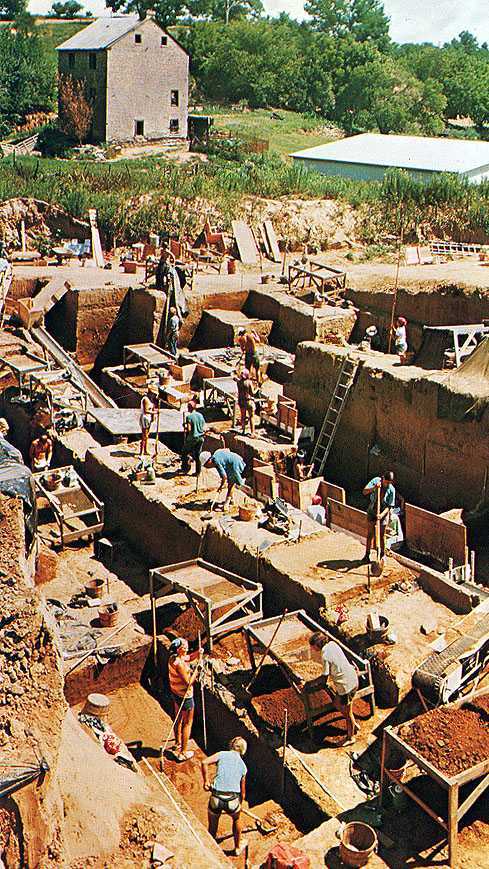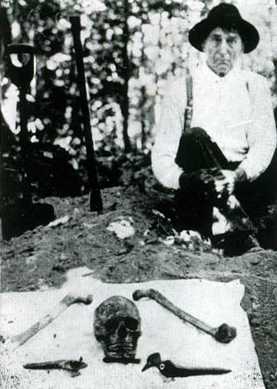Stone's Archaeology Pages
Est. 1999
From the earliest years of my childhood, I have been fascinated with Paleontology, Archaeology, Geology, and related sciences. I collected marine fossils during my younger years, and still poke around certain shorelines just for the pleasure of finding new specimens to add to my collection.
I have long been interested in the prehistoric cultures of the world, and particularly with those of my own ancestry. I found my first arrowhead when I was about 11 years old. I still have it. Since that time I've found many artifacts on the beaches and shores of Mobjack Bay--some of the best days of my life have been spent in the quiet solitude of ancient campsites...


| |

~THE SELLING OF AMERICAN PREHISTORY~
Shovel-toting ignoramii are robbing America of its Past!
The depredations of shovel-wielding pot-hunters, burial-mound looters, and inethical collector-dealers are destroying ancient sites for their artifacts.
Foregoing of any efforts to record information or data from their diggings, looters deny the American Public any shred of a chance to learn about these vanished cultures and often for nothing more than the God-All-Mighty Dollar.....
Far too many dealers openly sanction the digging of ancient Indian sites, citing private-property rights...and the losses of cultural and archaeological resources, including educational resources and knowledge, are staggering.
In addition to collector-dealer driven destruction, in large part created by a 'round-the-world internet-marketing of Ancient Amerind Antiquities, the depredations of greedy land-developers is an even greater problem. Vast acreages, containing sites dating back to the advent of the first people to inhabit this continent, are routinely destroyed with little or no investigation of known or suspected sites. The problem is not limited to prehistoric sites alone--historic sites of great cultural significance, too, are bulldozed under.
With little to stem the tide of rampant and unchecked realestate developement, and virtually no effective laws geared to preserve the private-property Archaeological and Cultural Resources of America, this nation faces a very real possibility that said resources will be utterly destroyed within a few decades!

COLLECTING OF ARTIFACTS THREATENED BY LOOTERS:
SITES DESTROYED, PRO'S SEEK NEW LAWS TO PROHIBIT SURFACE-COLLECTING FROM ANY REGISTERED SITE

Of considerable concern to ethical collectors and avocational archaeologists alike are the laws now established in Ohio and Indiana which threaten the scientific community's access to undiscovered/unreported sites. At the heart of the matter are laws passed by both states making it a felony to remove any artifact or relic from any already registered site--a move which threatens the artifact-collecting hobbyist's past-time.
Underlying this move by both states are the long histories of looting and plunder of ancient sites and burials, by individuals who either to dig-to-sell-for-profit, or merely to add to their own collections. The range and scope of damages done thus far have placed numerous sites in imminent danger of total destruction, without a single shred of scientific evidence having been gathered from them. The losses to our knowledge of the past is inconceivable--and yet the digging goes on...

At Left is a view of the dig at the Koster Farm in Illinois. Without the information passed on by collectors to archaeologists, this world-famous site would never have been excavated. We should be thankful to the artifact collectors who brought this important site to the attention of Dr Stuart Struever, who excavated the site, for the important new knowledge this site has revealed concerning prehistoric lifeways and the evolution of Subsistance-Strategies...
Dr Struevers' book "KOSTER: Americans in Search of their Prehistoric Past", Anchor Press/Doubleday, 1979, is a MUST-READ for the hobbyist and the avocationalist! | |
"To disturb a mound, an earthwork, burial or thing" from any registered site within the states of Ohio and Indiana, including registered sites on private property, is now illegal.
Avocational archaeologists and collectors following ethical standards of their hobby become the very instrument by which a site will often become recognized by professional archaeologists. These anti-collector laws jeopardize this instruments' function within the discovery-process, and collectors may not bother reporting new sites to state officials in the future. This in turn undermines the proprietary legacy by which American citizens have up until now been the unchallenged co-caretakers, along side the institution of organized archaeology, of America's historical and archaeological past. It is through this means that American citizens hold the past, present and future in their hands in such form as heirlooms for posterity.
The effects of these states' laws are likely to be felt across the country--thus it is critical that collectors act and collect in an ethical manner that seeks to preserve the contextual-integrity of archaeological sites. In its' simplest terms, this means DON'T DIG!
Ethical and moral collection-practices are a must for the survival of both the hobbyists' and the professional archaeologists' interests, and are a perquisite for the preservation of knowledge for generations to come. To this end, two internet websites have geared their content to provide for greater understanings of the problems, and to assist in providing and implementing solutions.
The Dirt Brothers, whose web-pages illustrate what can be done with sites slated for developement, have made an heroic effort to salvage the remnants of the Onion Creek Site--right from under the blades of working bulldozers. Just outside of San Antonio, Texas, the Onion Creek Site was largely ignored by state archaeological officials, and pleas to excavate and/or make some effort to record vital information/data from this site PRIOR to its developement went ignored.
The proof is in the pudding, as they say, and as a result of work performed by an all-vollunteer team of concerned avocational archaeologists, vast quatities of material have been salvaged from destruction (often from right under the bulldozers' blade), and the states' archaeological officials have come to recognize both Bob Wishoff for his accomplishments, and the significant finds he's made which have been preserved from sure destruction...
The essential focus in preserving American's rights to hunt for, find, hold and own artifacts is to promote ethical standards and to work within both the professional archaeological- and collector-communities.

The sort of looting depicted here, a horrid behavior in itself, threatens collectors' rights by its shear offensiveness, and belongs in the past, never to surface again in the collector-community, lest legislation overtake the collector and his rights... | |

It may be fairly stated that Archaeology
is not about the relics a people made,
it is about the people who made them

The Late Dr. H.M. Wormington, eminent archaeologist and author, sums up the dilemma posed by those who would carelessly dig for relics, their sole purpose being to acquire specimens, in this excerpt from "Ancient Man in North America", one of her most definitive works:
(Regarding the Clovis, NM site where, in a gravel pit, Clovis and Folsom points were found mixed with the bones of mammoth and bison, but had not been found in specific association with them—a circumstance much sought after)
...More clear-cut proof might have been available had it not been for a local collector who later reported finding a small true Folsom imbedded in a bison vertebra lying in position in an upper level (of the Clovis gravel pit). Instead of bringing it to the attention of a trained observer, or even removing the matrix containing the bone so that the association could be seen, he removed the vertebra and pulled the Folsom point from it. This is a perfect example of the harm that can be done by a “relic hunter” who is concerned only with adding to his collection and not with contributing to scientific knowledge. It should be noted to how short-sighted such a policy is. The value of any collection will be immeasurably enhanced by the addition of a well-documented specimen; but the same specimen, no matter how fine it may be, is practically valueless if it has been torn from its context without being properly studied…

I have said my piece here. Enjoy my pages' contents; check out some of the links I've placed on my pages--no one is too old to learn even a little bit more... I do not wish to carry a debate on in my pages, but desire only to illustrate the achievements of my peoples' Traditions, Lifeways, and Spirituality, through an understanding of the tool-traditions and cultural practices which evolved within these three precepts.
| |
Hints of Oral Tradition
during the Paleo-Transitional Period!?
I begin this with an example which can be said to imply the exsistance of Oral Tradition as early as the paleo Indian Period.
The most unique feature discovered at the Baucom-Hardaway Site consists of a series of firepits, assumed to be ceremonial features, in the Palmer Corner-Notched, Hardaway Side-Notched, and the Hardaway-dalton levels.
A total of seven firepit-features were excavated within the vertical and horizontal space of a single square (square b-6)
(figure 1).
The site was gridded off in 5-foot squares. Two of these features were excavated in the Palmer level, two more in the Hardaway level, and three such features in the Hardaway-Dalton level. Six of these firepit/ceremonial features (two in each level), almost identical in size, configuration and construction, were all built upon virtually the same spot.
Why were identical 'firepits' built during three related cultural periods, over a span of what must have been hundreds of years? Each previous set of 'firepits' was covered over by many inches of sediment--what tradition, what ceremonial need, would so compel three related cultures to return to the precise place again and again to build a pair of 'firepits'.
Each of the six 'firepit'- features, aproximately 18" in diameter, consists of one large stone and several medium to small stones forming a circle. In the center of each of these six 'firepits' were placed a number of small white quartz pebbles. The larger stones are all firecracked and heat-reddened in color; they seem unusually light in weight. The seventh 'firepit', found in the Hardaway-Dalton level, consisted of several medium-sized stones stacked two stones high; no pebbles were found to be in the center of the feature. No other such features were found on the site, and the circumstances of the relationships between the 'firepits' is unique to the studies of Paleo Indian archaeology in North America.
Links to additional pages...
Stone's Archaeology Pages-- Flaking Styles
Beveling, Clovis Hunter Settlement Patterns, etc.
What is Archaeology
>>>>>Stone's Archaeology<<<<<
Matt Rowe's Collection of Artifacts--this man has been busy!
North Carolina Archaeology
Peabody Museum of Archaeology and Ethnology, Harvard University
PROJECTILE POINT TYPES - Neverending DRAFT Bibliography
Essential Features of Adena Ritual
Lower Illinois River Valley Settlement Patterns
Native American Studies Collections

Email: stone@crosslink.net
| | | | | | | | | | |









